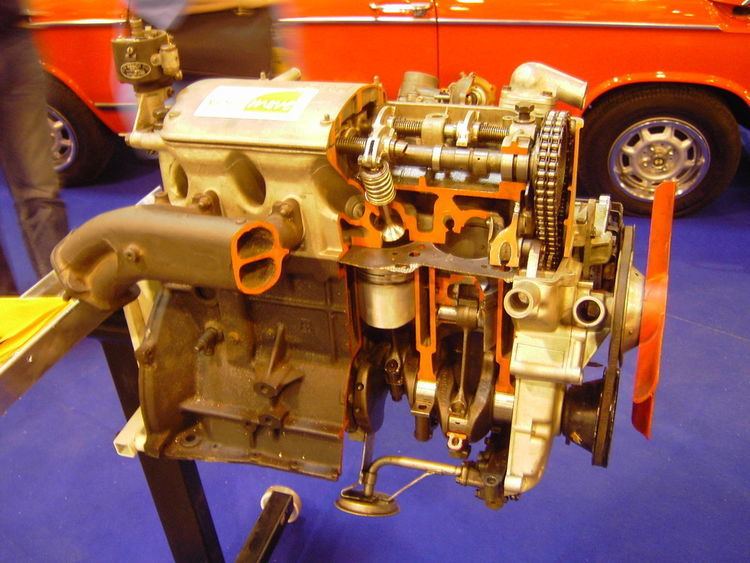Configuration SOHC Straight-4 | Production 1962–1988 | |
 | ||
The BMW M10 is a straight-4 SOHC piston engine produced from 1962 to 1988 with displacements ranging from 1499 cc to 1990 cc. It was first released in the New Class sedans and began to be phased out following the introduction of the M40 engine in 1987.
Contents
- Development
- Naming conventions
- M115
- M116
- M41
- M98
- M118
- M10
- M10B18
- M05
- M17
- M15
- M431
- M64
- M31
- M12 turbocharged motorsport version
- S14 version
- References
The engine was a commercial success for the Bavarian carmaker, with over 3.5 million produced in almost three decades across many BMW models. It has a forged crankshaft, counter balance weights, five main bearings and a chain-driven camshaft. The block is made from cast iron and the head is made from aluminium.
It was also used as the basis for the turbocharged BMW M12 motorsport engine, which for instance was used by Brabham-BMW in the Formula One racing series.
Development
The engine was designed by engineer and race driver Baron Alex von Falkenhausen. In the late 1950s, he was asked to design a small-displacement (1.3 L) engine, but felt that this would be insufficient for the company's future needs. Therefore, he convinced BMW that the capacity should be 1.5 L instead and he designed a block that could be expanded to 2.0 L in the future. BMW M10 Engine utilized Hemispherical combustion chamber in 8 valve arrangement.
Naming conventions
The engine was initially known as the "M115" (the last two digits representing the 1.5 litre capacity). Over the years, variants of the engine were given various codes (most of them starting with "M1..." and the remaining digits relating to the capacity). In 1975, the engine became known as then "M10", then in 1980 it was given the standardised BMW engine code of M10B18 (where "M10" represents the series and the "18" represents the 1.8 litre capacity).
The M115 and all related engines have become retrospectively known as the "M10" family.
M115
The 1.5 L (1499 cc/91 in3) M115 produced 75 hp or 80 hp (56 kW or 60 kW), depending on carburetor.
Applications:
M116
The 1.6 L (1573 cc/95 in3) M116 used a Solex 38 PDSI carburettor and produced 63 kW (84 hp). Bore was 84 mm and stroke was 71 mm.
Applications:
A version using two Solex 40 PHH carburettors produced 78 kW (105 hp)
Applications:
M41
The 1.6 L (1573 cc/95 in3) M41 produced 90 hp (67 kW) and 123 lb·ft (167 N·m).
Applications:
M98
The 1.6 L (1573 cc/95 in3) M98 used a Pierburg 1B2 carburettor and produced 55 kilowatts (74 hp).
Applications:
M118
The 1.8 L (1773 cc/108 in3) M118 used a Solex DIDTA 32/32 carburettor and produced 66 kW (89 hp).
Applications:
M10
The 1.8 L (1766 cc/107 in3) M10 used a Solex 32 DIDTA carburettor and 72 kW (97 hp).
Applications:
M10B18
The version using a Pierburg 2B4 carburettor produced 66 kW (89 hp).
Applications:
The version using Bosch K-Jetronic fuel injection produced 77 kW (103 hp).
Applications:
M05
The 2.0 L (1990 cc/121 in3) M05 has a bore of 89 mm and a stroke of 80 mm. Using a single Solex 40 PDSI carburettor, it produced 75 kW (101 hp).
Applications:
Using twin Solex 40 PHH carburettors, it produced 89 kW (119 hp).
M17
The 2.0 L (1990 cc/121 in3) M17 used a Stromberg 175 CDET carburettor and produced 85 kW (114 hp).
Applications:
M15
The 2.0 L (1990 cc/121 in3) M15 used the Kugelfischer mechanical fuel injection and produced 97 kW (130 hp). It was the famed tii engine.
Applications:
M43/1
The 2.0 L (1990 cc/121 in3) M43/1 used a Solex 32-32 DIDTA carburettor and produced 80 kW (107 hp).
Applications:
M64
The 2.0 L (1990 cc/121 in3) M64 used K-Jetronic fuel injection and produced 125 hp (93 kW).
Applications:
M31
The 2.0 L (1990 cc, 121 in3) M31 used a KKK turbocharger and Kugelfischer P04 mechanical fuel injection with a sliding throttle plate. It produced 170 hp (125 kW).
Applications:
M12 turbocharged motorsport version
The M10 was used as the basis for the highly successful M12 turbocharged motorsport engine.
S14 version
The S14 engine for the E30 BMW M3 was based upon the M10 block.
